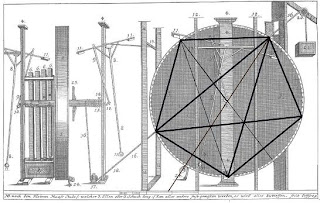The first and most obvious one was his pseudonym - Orffyreus. It is easy to see how he arrived at it but not so clear why. Many writers from every age chose pseudonyms - modern day pseudomyms include the following; Mark Twain's real name was Samuel Clemens; Woody Alle - Allen Stewart Konigsberg; Fred Astaire - Frederick Austerlitz. In and around Bessler's day; Molière - Jean Baptiste Poquelin; Voltaire - François-Marie Arouet - and Theophrastus Bombastus von Hohenheim, 1493-1541, physician, alchemist, and mystic, more popularly known as Paracelsus!.
But the way Bessler chose his pseudonym was unusual. The method, described as the atbash cipher is a simple substitution cipher for the Hebrew alphabet. In the English language the first 13 letters: A|B|C|D|E|F|G|H|I|J|K|L|M are place above the last 13 Letters: Z|Y|X|W|V|U|T|S|R|Q|P|O|N.
The order of the underneath row can be reversed as in Bessler's case. A similar cipher, known as the albam cipher required two alphabets.
|
We know he learned some Hebrew in Prague while staying with the Jesuit and the Rabbi, it seems obvious that he learned of the cipher then, but why would he choose that method to create a pseudonym? No simple name changes as in the examples above and as far as I can find out, no-one else adopted such a method for their pseudonym - nor the encodement of their real name.
The reason must be linked to a desire to at least convey the impression that he was knowledgeable about ciphers and it is but a short step to conclude that he did that because he had put some encoded writing where people could read it. I can see no reason why he would have wished to convey that impression unless there was a good reason for it and that conclusion is supported both by his own comments in Apologia Poetica as well as subsequent discoveries indicating the presence of alphabetic/numeric ciphers.
What information might that have been? Either his chance to have the last laugh by explaining how he cheated everyone - or the real explanation of how his wheel worked, and I simply cannot accept that the former might have been true. His tortured writing about the misery he has suffered at the hands of Gartner, Wagner and Borlach ring true.
Over the last few years I have published on my other websites my theories on why his machine did not violate the physical laws and also I have provided many examples of encoded material - too much to explain away as coincidence in my opinion. I have a number of other examples which I am not ready to share yet but in summary I don't think there is any doubtr that Bessler left clues behind him. Their purpose was two-fold, firstly to make people think there was information about his machine to be found within his published works, and secondly that information was there to be deciphered and it would explain how his wheel was constructed. As I have said several times now, the information is both graphic and textual and should mainly be looked for inhis published works.
JC
10a2c5d26e15f6g7h10ik12l3m6n14o14r5s17tu6v5w4y4-3,’.

.jpg)







